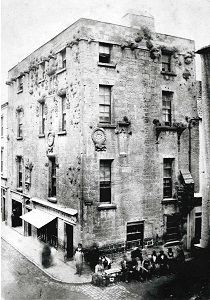LYNCH’S CASTLE

by Tom Kenny
Lynch’s Castle is one of the finest surviving medieval town-houses, one of the best known examples of pre-Renaissance architecture in Ireland. It is essentially a two-period structure, the original sixteenth castle was square in plan and was limited to the space now occupied on the ground floor by the vestibule of the bank. That portion to the west on Shop Street was added c.1808. The extension is evident in the masonry of the exterior of the building, and the window hood-moulds of this section are very different in the character of their detail and carving from the original work. It is likely that the whole interior was remodelled and the storeys altered at this time, the window hood-moulds, the panels, the gargoyles etc. being moved to their present positions.
As a result, the original location of these features can only be conjectured. An examination of the moulding profiles and other ornamental details suggests that many of them belonged to the original castle, or were the product of the same workshop. They are finely carved from local limestone and in their richness and abundance of detail bear witness to the wealth of Galway merchants in the early 16th century.
The early features worthy of note are preserved on the exteriors of the Shop Street and Abbeygate Street walls. Although it is not known which member of the Lynch family built the castle, his coat of arms and merchant’s mark may be seen on the hood-mould stops of the second-storey window. His mark is also carved beneath the stops of the third-storey windows. There is a large rectangular panel in this wall which bears the Royal Arms of Henry VII, king of England, 1485-1509. There are many other important features including an enigmatic carving of a lion (often erroneously considered to be a monkey) holding an animal in its claws and biting its head. The gargoyles are comparable with those on St. Nicholas’ Collegiate Church, though they no longer serve their original purpose of carrying water from the roof clear of the building.
The premises were again much altered in 1880 when Peter Kirwan bought it from the Right Honourable Henry Ormsby. Kirwan had a candle making shop there on Shop Street as can be (just about) seen from out photograph dated c.1870. The Connaught Fruit Store was located next door in 1902. We have an advertisement for a Cigar Emporium there at that time promoting ‘The finest stock of Tobaccos, Cigars, Cigarettes and Tobacconist’s Fancy Goods in Town’. In 1903, that shop became ‘The Castle Bar’ run by a Mr. James A. Smyth.

In 1918, Peter Kirwan’s daughter, a Mrs. N.M. Burke put the castle up for auction as you can see form our advertisement which was published in the Tuam Herald. The Munster and Leinster Bank leased it from her as a preliminary to outright purchase. They converted the two shops on the ground floor into the bank office. The round-headed windows and doorways were inserted in the early 1930’s. The main entrance doorway was carved by Dublin sculptor Lawrence Campbell and bears representation of arms symbolising the four provinces of Ireland. In the course of extending the bank premises at this time, and early seventeenth century fireplace was discovered and re-erected in the vestibule.
During the years 1964-66, the then manager Frank Dorgan had the exterior stonework cleaned and re-pointed and added an extension on the Abbeygate Street side. In the early seventies, further alterations including floodlighting were carried out on this section`. Indeed, we should be grateful to Allied Irish Banks for taking such care with the maintenance of this iconic building.
